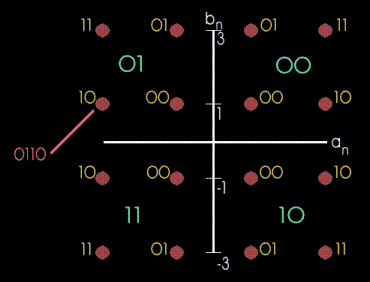carrierless amplitude-phase modulation (CAP)
Carrierless Amplitude-PhaseModulation(CAP) is a combined carrierlessphase and amplitude modulation used, for example, to transmit ATM at 155 Mbit/s over Category 3 copper cables.
CAP coding is a variant of quadrature ampl itude modulation( QAM) in which the amplitude and phase are modulated. Thus, a CAP-4 system can be thought of as having four voltage levels, e.g., +2 V, +1 V, -1 V, and -2V. At each voltage level, information from two bits can be represented, e.g., +2 V as 00, +1 V as 01, etc. This would halve the emission levels for the same bit rate compared to a two-level system. If the system is transferred to 16 planes (CAP 16), a sequence of four bits can be represented on each plane, i.e. `2^4`.
In the case of CAP-32 coding, this technique allows a transmission speed of 155 Mbit/s with a transmission frequency of 31.25 MHz, because 5 bits are transmitted with each oscillation. More recent developments such as CAP-64 use a transmission frequency of 64.5 MHz, which corresponds to a data transfer rate of 300 Mbit/s.
CAP-16 is used as a transmission method in ATM via category 3 UTP cable, but only at transmission rates of 51.84 Mbit/s.

